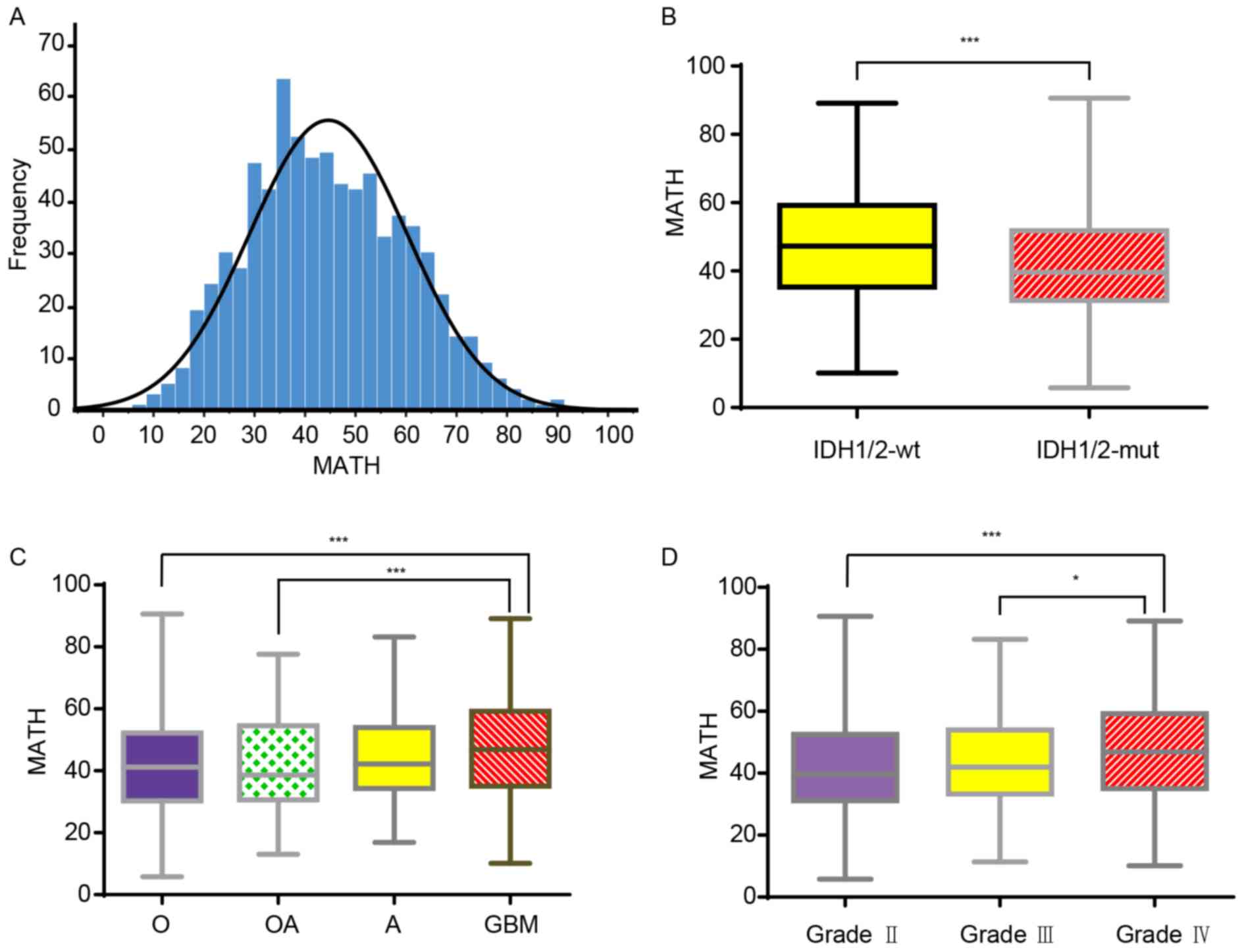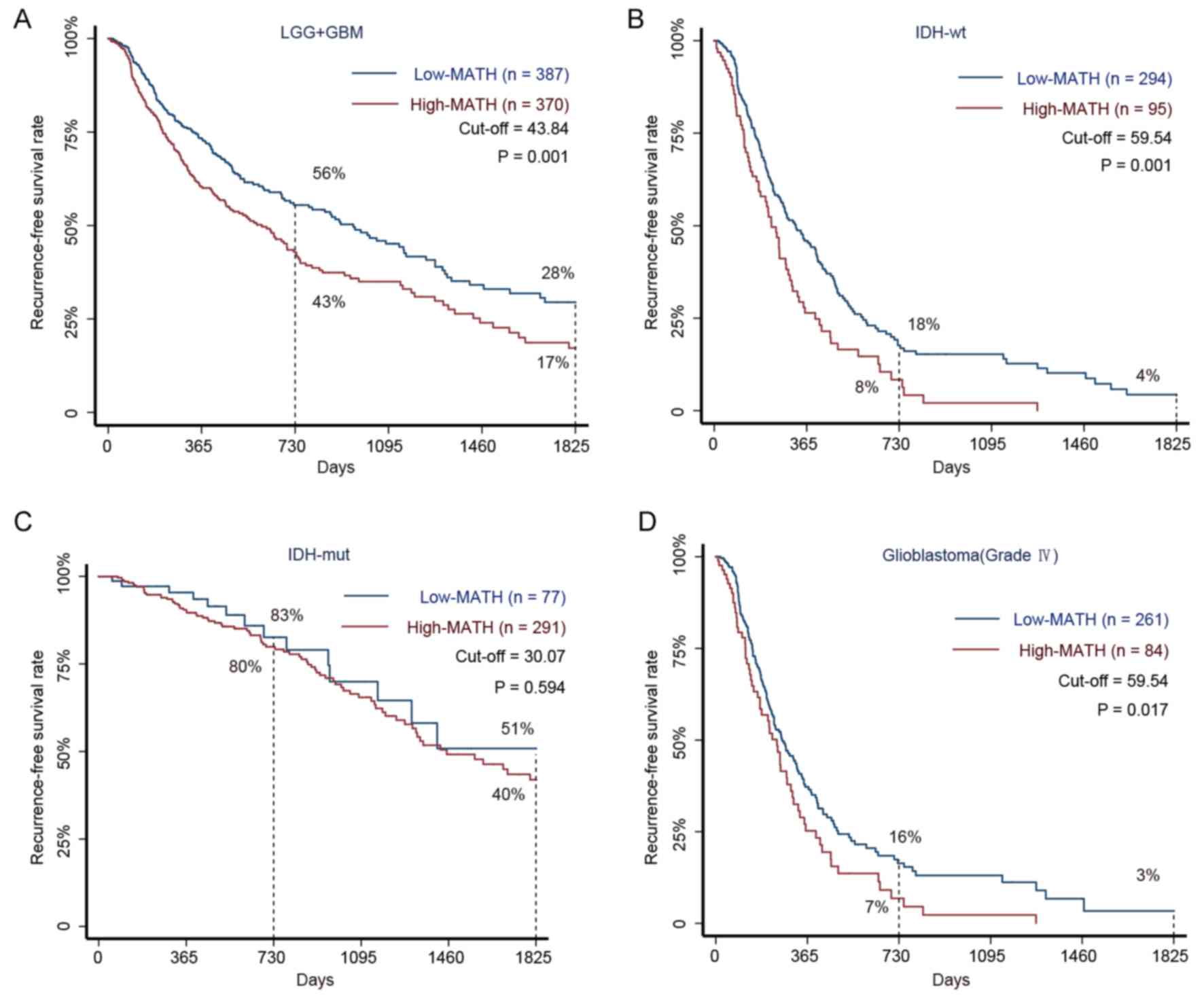|
1
|
Wood MD, Halfpenny AM and Moore SR:
Applications of molecular neuro-oncology-A review of diffuse glioma
integrated diagnosis and emerging molecular entities. Diagn Pathol.
14:292019. View Article : Google Scholar : PubMed/NCBI
|
|
2
|
Freese C, Takiar V, Fouladi M, DeWire M,
Breneman J and Pater L: Radiation and subsequent reirradiation
outcomes in the treatment of diffuse intrinsic pontine glioma and a
systematic review of the reirradiation literature. Pract Radiat
Oncol. 7:86–92. 2017. View Article : Google Scholar : PubMed/NCBI
|
|
3
|
Lin L, Cai J and Jiang C: Recent advances
in targeted therapy for glioma. Curr Med Chem. 24:1365–1381. 2017.
View Article : Google Scholar : PubMed/NCBI
|
|
4
|
Kline C, Felton E, Allen IE, Tahir P and
Mueller S: Survival outcomes in pediatric recurrent high-grade
glioma: Results of a 20-year systematic review and meta-analysis. J
Neurooncol. 137:103–110. 2018. View Article : Google Scholar : PubMed/NCBI
|
|
5
|
Johnson BE, Mazor T, Hong C, Barnes M,
Aihara K, McLean CY, Fouse SD, Yamamoto S, Ueda H, Tatsuno K, et
al: Mutational analysis reveals the origin and therapy-driven
evolution of recurrent glioma. Science. 343:189–193. 2014.
View Article : Google Scholar : PubMed/NCBI
|
|
6
|
Sottoriva A, Spiteri I, Piccirillo SG,
Touloumis A, Collins VP, Marioni JC, Curtis C, Watts C and Tavaré
S: Intratumor heterogeneity in human glioblastoma reflects cancer
evolutionary dynamics. Proc Natl Acad Sci USA. 110:4009–4014. 2013.
View Article : Google Scholar : PubMed/NCBI
|
|
7
|
Mazor T, Pankov A, Johnson BE, Hong C,
Hamilton EG, Bell RJA, Smirnov IV, Reis GF, Phillips JJ, Barnes MJ,
et al: DNA methylation and somatic mutations converge on the cell
cycle and define similar evolutionary histories in brain tumors.
Cancer Cell. 28:307–317. 2015. View Article : Google Scholar : PubMed/NCBI
|
|
8
|
Zhao Y, Alakhova DY and Kabanov AV: Can
nanomedicines kill cancer stem cells? Adv Drug Deliv Rev.
65:1763–1783. 2013. View Article : Google Scholar : PubMed/NCBI
|
|
9
|
Brown TM and Fee E: Rudolf carl virchow:
Medical scientist, social reformer, role model. Am J Public Health.
96:2104–2105. 2006. View Article : Google Scholar : PubMed/NCBI
|
|
10
|
Nowell PC: The clonal evolution of tumor
cell populations. Science. 194:23–28. 1976. View Article : Google Scholar : PubMed/NCBI
|
|
11
|
Kim J, Lee IH, Cho HJ, Park CK, Jung YS,
Kim Y, Nam SH, Kim BS, Johnson MD, Kong DS, et al: Spatiotemporal
evolution of the primary glioblastoma genome. Cancer Cell.
28:318–328. 2015. View Article : Google Scholar : PubMed/NCBI
|
|
12
|
Kim H, Zheng S, Amini SS, Virk SM,
Mikkelsen T, Brat DJ, Grimsby J, Sougnez C, Muller F, Hu J, et al:
Whole-genome and multisector exome sequencing of primary and
post-treatment glioblastoma reveals patterns of tumor evolution.
Genome Res. 25:316–327. 2015. View Article : Google Scholar : PubMed/NCBI
|
|
13
|
Sidow A and Spies N: Concepts in solid
tumor evolution. Trends Genet. 31:208–214. 2015. View Article : Google Scholar : PubMed/NCBI
|
|
14
|
Ibragimova MK, Tsyganov MM and Litviakov
NV: Natural and chemotherapy-Induced clonal evolution of tumors.
Biochemistry (Mosc). 82:413–425. 2017. View Article : Google Scholar : PubMed/NCBI
|
|
15
|
Mroz EA and Rocco JW: MATH, a novel
measure of intratumor genetic heterogeneity, is high in
poor-outcome classes of head and neck squamous cell carcinoma. Oral
Oncol. 49:211–215. 2013. View Article : Google Scholar : PubMed/NCBI
|
|
16
|
Mroz EA, Tward AD, Hammon RJ, Ren Y and
Rocco JW: Intra-tumor genetic heterogeneity and mortality in head
and neck cancer: Analysis of data from the cancer Genome Atlas.
PLoS Med. 12:e10017862015. View Article : Google Scholar : PubMed/NCBI
|
|
17
|
Rajput A, Bocklage T, Greenbaum A, Lee JH
and Ness SA: Mutant-allele tumor heterogeneity scores correlate
with risk of metastases in colon cancer. Clin Colorectal Cancer.
16:e165–e170. 2017. View Article : Google Scholar : PubMed/NCBI
|
|
18
|
Ma D, Jiang YZ, Liu XY, Liu YR and Shao
ZM: Clinical and molecular relevance of mutant-allele tumor
heterogeneity in breast cancer. Breast Cancer Res Treat. 162:39–48.
2017. View Article : Google Scholar : PubMed/NCBI
|
|
19
|
Shen S, Wei Y, Zhang R, Du M, Duan W, Yang
S, Zhao Y, Christiani DC and Chen F: Mutant-allele fraction
heterogeneity is associated with non-small cell lung cancer patient
survival. Oncol Lett. 15:795–802. 2018.PubMed/NCBI
|
|
20
|
Turkalp Z, Karamchandani J and Das S: IDH
mutation in glioma: New insights and promises for the future. JAMA
Neurol. 71:1319–1325. 2014. View Article : Google Scholar : PubMed/NCBI
|
|
21
|
Alexander BM and Cloughesy TF: Adult
glioblastoma. J Clin Oncol. 35:2402–2409. 2017. View Article : Google Scholar : PubMed/NCBI
|
|
22
|
Li S, Yang R, Sun X, Miao S, Lu T, Wang Y,
Wo Y and Jiao W: Identification of SPP1 as a promising biomarker to
predict clinical outcome of lung adenocarcinoma individuals. Gene.
679:398–404. 2018. View Article : Google Scholar : PubMed/NCBI
|
|
23
|
Claus EB, Walsh KM, Wiencke JK, Molinaro
AM, Wiemels JL, Schildkraut JM, Bondy ML, Berger M, Jenkins R and
Wrensch M: Survival and low-grade glioma: The emergence of genetic
information. Neurosurg Focus. 38:E62015. View Article : Google Scholar : PubMed/NCBI
|
|
24
|
Babu R, Bagley JH, Park JG, Friedman AH
and Adamson C: Low-grade astrocytomas: The prognostic value of
fibrillary, gemistocytic, and protoplasmic tumor histology. J
Neurosurg. 119:434–441. 2013. View Article : Google Scholar : PubMed/NCBI
|
|
25
|
Tom MC, Park DYJ, Yang K, Leyrer CM, Wei
W, Jia X, Varra V, Yu JS, Chao ST, Balagamwala EH, et al: Malignant
transformation of molecularly classified adult low grade glioma.
Int J Radiat Oncol Biol Phys. Aug 25–2019.(Epub ahead of print).
View Article : Google Scholar
|
|
26
|
Tykocki T and Eltayeb M: Ten-year survival
in glioblastoma. A systematic review. J Clin Neurosci. 54:7–13.
2018. View Article : Google Scholar : PubMed/NCBI
|
|
27
|
Ghosh D, Nandi S and Bhattacharjee S:
Combination therapy to checkmate Glioblastoma: Clinical challenges
and advances. Clin Transl Med. 7:332018. View Article : Google Scholar : PubMed/NCBI
|
|
28
|
Lee JK, Wang J, Sa JK, Ladewig E, Lee HO,
Lee IH, Kang HJ, Rosenbloom DS, Camara PG, Liu Z, et al:
Spatiotemporal genomic architecture informs precision oncology in
glioblastoma. Nat Genet. 49:594–599. 2017. View Article : Google Scholar : PubMed/NCBI
|
|
29
|
Suzuki H, Aoki K, Chiba K, Sato Y,
Shiozawa Y, Shiraishi Y, Shimamura T, Niida A, Motomura K, Ohka F,
et al: Mutational landscape and clonal architecture in grade II and
III gliomas. Nat Genet. 47:458–468. 2015. View Article : Google Scholar : PubMed/NCBI
|
|
30
|
Qazi MA, Vora P, Venugopal C, Sidhu SS,
Moffat J, Swanton C and Singh SK: Intratumoral heterogeneity:
Pathways to treatment resistance and relapse in human glioblastoma.
Ann Oncol. 28:1448–1456. 2017. View Article : Google Scholar : PubMed/NCBI
|
|
31
|
Bernstock JD, Mooney JH, Ilyas A, Chagoya
G, Estevez-Ordonez D, Ibrahim A and Nakano I: Molecular and
cellular intratumoral heterogeneity in primary glioblastoma:
Clinical and translational implications. J Neurosurg. 1-9:Aug
23–2019.(Epub ahead of print).
|
|
32
|
Yang MC, Loh JK, Li YY, Huang WS, Chou CH,
Cheng JT, Wang YT, Lieu AS, Howng SL, Hong YR and Chou AK: Bcl2L12
with a BH3-like domain in regulating apoptosis and TMZ-induced
autophagy: A prospective combination of ABT-737 and TMZ for
treating glioma. Int J Oncol. 46:1304–1316. 2015. View Article : Google Scholar : PubMed/NCBI
|
|
33
|
Rocha CR, Garcia CC, Vieira DB, Quinet A,
de Andrade-Lima LC, Munford V, Belizário JE and Menck CF:
Glutathione depletion sensitizes cisplatin- and
temozolomide-resistant glioma cells in vitro and in vivo. Cell
Death Dis. 6:e17272015. View Article : Google Scholar : PubMed/NCBI
|
|
34
|
Turaga SM and Lathia JD: Adhering towards
tumorigenicity: Altered adhesion mechanisms in glioblastoma cancer
stem cells. CNS Oncol. 5:251–259. 2016. View Article : Google Scholar : PubMed/NCBI
|
|
35
|
Chen JW, Zhou CF and Lin ZX: The influence
of different classification standards of age groups on prognosis in
high-grade hemispheric glioma patients. J Neurol Sci. 356:148–152.
2015. View Article : Google Scholar : PubMed/NCBI
|
|
36
|
Gallego Perez-Larraya J and Delattre JY:
Management of elderly patients with gliomas. Oncologist.
19:1258–1267. 2014. View Article : Google Scholar : PubMed/NCBI
|
|
37
|
Rasmussen BK, Hansen S, Laursen RJ,
Kosteljanetz M, Schultz H, Nørgård BM, Guldberg R and Gradel KO:
Epidemiology of glioma: Clinical characteristics, symptoms, and
predictors of glioma patients grade I–IV in the the Danish
Neuro-Oncology Registry. J Neurooncol. 135:571–579. 2017.
View Article : Google Scholar : PubMed/NCBI
|
|
38
|
Chauveau C, Rowell J and Ferreiro A: A
rising titan: TTN review and mutation update. Hum Mutat.
35:1046–1059. 2014. View Article : Google Scholar : PubMed/NCBI
|
|
39
|
Yehia L, Ni Y and Eng C: Germline TTN
variants are enriched in PTEN-wildtype Bannayan-Riley-Ruvalcaba
syndrome. NPJ Genom Med. 2:372017. View Article : Google Scholar : PubMed/NCBI
|
|
40
|
Cho SY, Park C, Na D, Han JY, Lee J, Park
OK, Zhang C, Sung CO, Moon HE, Kim Y, et al: High prevalence of
TP53 mutations is associated with poor survival and an EMT
signature in gliosarcoma patients. Exp Mol Med. 49:e3172017.
View Article : Google Scholar : PubMed/NCBI
|
|
41
|
Todorova PK, Fletcher-Sananikone E,
Mukherjee B, Kollipara R, Vemireddy V, Xie XJ, Guida PM, Story MD,
Hatanpaa K, Habib AA, et al: Radiation-induced DNA damage
cooperates with heterozygosity of TP53 and PTEN to generate
high-grade gliomas. Cancer Res. 79:3749–3761. 2019. View Article : Google Scholar : PubMed/NCBI
|
|
42
|
Pessoa IA, Amorim CK, Ferreira WAS, Sagica
F, Brito JR, Othman M, Meyer B, Liehr T and de Oliveira EHC:
Detection and correlation of single and concomitant TP53, PTEN, and
CDKN2A alterations in gliomas. Int J Mol Sci. 20(pii): E26582019.
View Article : Google Scholar : PubMed/NCBI
|
|
43
|
Jesionek-Kupnicka D, Braun M,
Trabska-Kluch B, Czech J, Szybka M, Szymańska B, Kulczycka-Wojdala
D, Bieńkowski M, Kordek R and Zawlik I: MiR-21, miR-34a, miR-125b,
miR-181d and miR-648 levels inversely correlate with MGMT and TP53
expression in primary glioblastoma patients. Arch Med Sci.
15:504–512. 2019. View Article : Google Scholar : PubMed/NCBI
|
|
44
|
Forte IM, Indovina P, Iannuzzi CA, Cirillo
D, Di Marzo D, Barone D, Capone F, Pentimalli F and Giordano A:
Targeted therapy based on p53 reactivation reduces both
glioblastoma cell growth and resistance to temozolomide. Int J
Oncol. 54:2189–2199. 2019.PubMed/NCBI
|
|
45
|
Fischer NW, Prodeus A and Gariepy J:
Survival in males with glioma and gastric adenocarcinoma correlates
with mutant p53 residual transcriptional activity. JCI Insight.
3(pii): 1213642018. View Article : Google Scholar : PubMed/NCBI
|
|
46
|
Seow P, Wong JHD, Ahmad-Annuar A, Mahajan
A, Abdullah NA and Ramli N: Quantitative magnetic resonance imaging
and radiogenomic biomarkers for glioma characterisation: A
systematic review. Br J Radiol. 91:201709302018. View Article : Google Scholar : PubMed/NCBI
|
|
47
|
Aubry M, de Tayrac M, Etcheverry A,
Clavreul A, Saikali S, Menei P and Mosser J: From the core to
beyond the margin: A genomic picture of glioblastoma intratumor
heterogeneity. Oncotarget. 6:12094–12109. 2015. View Article : Google Scholar : PubMed/NCBI
|














